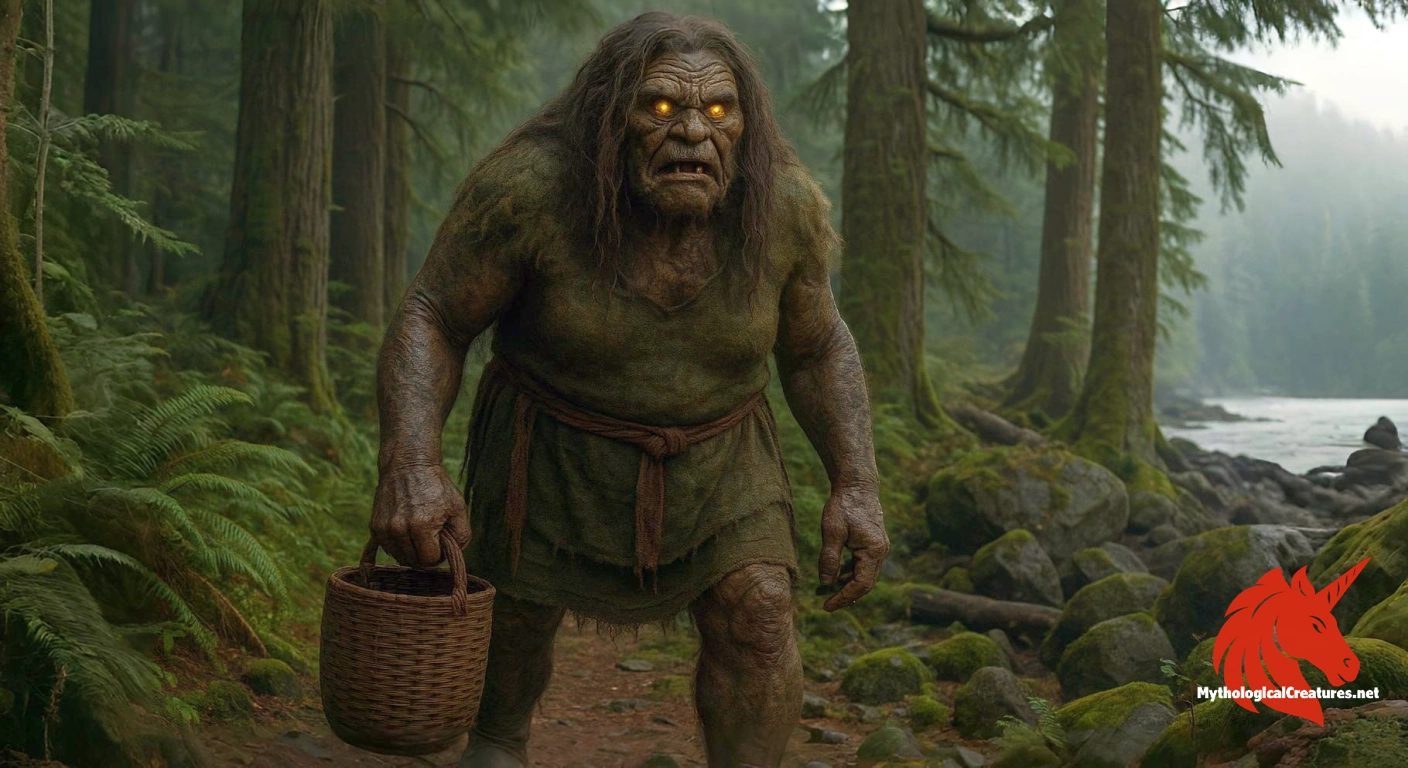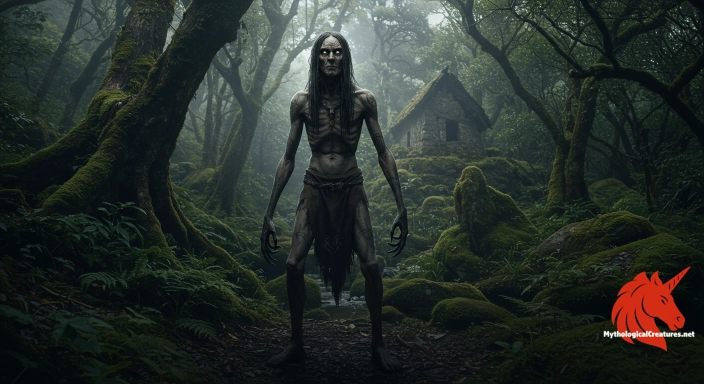Dzunukwa: Dzunukwa, also known as the Basket Ogress, is a fearsome figure from Kwakwaka'wakw and Nuu-chah-nulth mythology.

Dzunukwa
Dzunukwa - Represents the inescapable dangers of the wild and serves as a cultural warning in indigenous narratives
Origins & First Encounters
Dzunukwa, often referred to as the Basket Ogress and known by the variants Tsonoqua or Tsonokwa, emerges as one of the most captivating figures in the mythological landscape of the Pacific Northwest. Her narrative is deeply interwoven with the traditions of the Kwakwaka'wakw and Nuu-chah-nulth peoples, whose oral histories span many generations. The lore surrounding her is rich with symbolism, capturing both the lurking dangers of the wild and the nurturing aspects of ancestral nature. Her myth appears rooted in ancient perceptions of the natural world, where the physical environment and the spiritual realm coalesce. Early attestations of her exist in ritual performances, carving traditions, and storytelling, which served to consolidate community values and social norms. Many indigenous communities have long regarded her as a boundary figure, one residing at the intersection of order and chaos. In these narratives, her formidable presence underscores both caution and reverence for the natural forces that shape existence. The enduring nature of Dzunukwa’s myth not only highlights her role as a guardian of natural lore but also reflects the depth and complexity of indigenous worldviews.
Source Texts & Tale Variants
Primary sources for Dzunukwa emerge predominantly from the vibrant oral traditions and ceremonial practices of the Pacific Northwest peoples. Detailed accounts of her exploits and characteristics have been transmitted through meticulously preserved stories and ritual dances. Various narratives describe her as a mysterious, awe-inspiring entity whose actions range from whimsical to menacing, depending on the context of the tale. Recordings of these stories were later complemented by early anthropologists and ethnographers who documented the nuances of indigenous belief systems. With each retelling, different communities have amplified certain traits, resulting in a mosaic of story variants that enhance her character. Some tell of her as a figure who enforces moral conduct among children, while others portray her as a complex symbol of nature’s unpredictable temperament. Carved totem poles, masks, and other artefacts from the region also serve as visual texts that inform our understanding of her myth. The multiplicity of sources and versions ensures that her legend remains as diverse as the cultures that celebrate her, each contributing unique insights into her dual nature. In contemporary times, revitalised interest in native oral histories has further enriched and diversified the sources that document her enduring influence.
Form & Powers
Visually, Dzunukwa is often depicted as a colossal and formidable figure, with a physique that blends human and bestial qualities. Her body is commonly illustrated as being draped in long, unkempt hair which suggests both wildness and a connection to the forest’s untamed essence. Artistic representations frequently focus on her exaggerated features, including a broad, almost mythical countenance marked by deep-set eyes and an imposing stature. In some traditional depictions, she adorns a large, intricately woven basket on her head, which plays a pivotal role in symbolising her identity as the Basket Ogress. The contrast between her human-like form and animalistic details creates an ambiguous visual narrative that has both terrified and fascinated audiences. Variations in size also occur in different retellings, with some legends describing her as towering over mortals while others suggest a more earthly giant form intimately tied to her natural surroundings. Textural details such as rugged skin, tangled hair, and the inclusion of natural motifs in her attire further encode her connection to the wilderness. The physical portrayal of Dzunukwa evolves in harmony with the artistic styles of the region, ensuring that every depiction is steeped in symbolic significance and cultural resonance.
Regional Faces
Across the coastal and inland regions of the Pacific Northwest, the depiction of Dzunukwa adapts to reflect local cultural and environmental contexts. In Kwakwaka'wakw communities, she is sometimes portrayed with a dual temperament, combining elements of both punitive force and protective guidance. Meanwhile, Nuu-chah-nulth narratives tend to focus more sharply on her fearsome qualities, especially in tales that serve as warnings for disobedient children. The physical attributes and symbolic motifs associated with her often vary, with coastal interpretations frequently incorporating elements related to the sea and shoreline, whereas inland stories embed her within the dense, ancient forests. Each community adapts her image to mirror their own relationship with the surrounding landscape, using variations in her appearance to address local concerns and traditions. Regional artworks, such as masks and carvings, reveal subtle differences in how her features are rendered, sometimes emphasising a more benevolent aspect while at other times highlighting her uncontrollable nature. Local festivals and rituals occasionally spotlight her figure in dramatic performances that encapsulate the community’s values and inherent fears. These regional variations not only underline the adaptive nature of indigenous myth but also demonstrate how a single figure may embody multiple facets of cultural identity and environmental reverence.
Cultural Parallels
In a broader mythological context, Dzunukwa shares intriguing parallels with supernatural beings found in distant cultures. Similar to the ogres and wild women in European and other indigenous narratives, she occupies a liminal space between the human and the otherworldly. Her role as both a nurturer and a punisher invites comparisons with figures such as Baba Yaga, whose ambiguous morality mirrors the dual aspect of nature itself. Both she and her international counterparts serve as cautionary figures, warning children and adults alike of the consequences of deviating from accepted societal norms. Her basket motif can also be seen in varied cultural icons that symbolise the containment of chaos or the holding of sacred power. The universal archetype of a creature that navigates the border between civilization and the wild imbues Dzunukwa’s myth with a resonant, cross-cultural appeal. These comparative narratives underscore a common human impulse to personify nature's mysteries and to embody its awe-inspiring forces in tangible form. The study of such figures across different traditions reveals deep-rooted themes of transformation, retribution, and protection. Through this lens, Dzunukwa not only embodies the unique spiritual heritage of the Pacific Northwest but also speaks to a global narrative about the relationship between humanity and the untamed natural world.
Legacy & Modern Evolution
Over time, the myth of Dzunukwa has undergone significant evolution, reflecting broader changes in both indigenous cultures and global perceptions of myth. Initially a fearsome embodiment of the wild, her narrative has gradually embraced a more nuanced role that incorporates themes of protection, transformation, and even resilience. Modern indigenous artists and cultural activists have reinterpreted her image in contemporary media, ranging from traditional carvings to innovative digital art forms. This revitalisation has allowed her character to serve as a potent symbol of environmental stewardship and cultural continuity amid rapid modernisation. Increased academic interest and indigenous-led cultural revivals have further bolstered her stature as an emblem of ancestral wisdom and natural power. Alongside renewed public exhibitions and performances, her image has found a place in urban art and community storytelling events, bridging the gap between ancient lore and modern life. As interpretations evolve, Dzunukwa remains a touchstone for conversations about identity, environmental ethics, and the importance of preserving indigenous traditions. Her myth now resonates not only as a cautionary tale but also as a narrative of empowerment that speaks to contemporary struggles and aspirations. The continuing evolution of her legacy underscores the dynamic nature of myth-making, reflecting how timeless stories adapt to encapsulate the priorities and imaginations of new generations.
Interesting Fact
An interesting aspect of Dzunukwa is that her basket, central to her identity, symbolises both abundance and the inescapable grasp of fate within indigenous narratives.
Quick Creature Info
Origin:
Features:
Associations:
Our Mythic Legendary Rating:

Also Sometimes Known As:
Habitat:
Supernatural Powers:
Physical Attributes:
Abilities:
Behavior:
Lore:
Related Creatures, Tales or Lore
- BBaba Yaga
- RRakshasi
- MMedusa
References
Discover Another Mythical Legend You May Not Have Heard Of?
Uncover the mysteries of ancient folklore and expand your knowledge of legendary beings from cultures around the world.
Dare to Meet the Kalku....
Curated by the Mythological Creatures Team (rev. May 2025)
